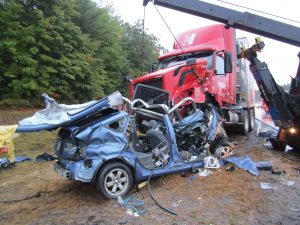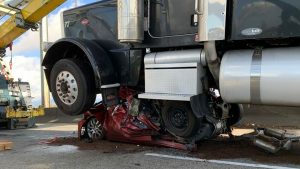 A family member was killed or catastrophically injured in a crash with a big truck. These accidents often cause death or serious brain, burn, amputation, and back injuries. It is your responsibility to decide how to proceed. What should you do?
A family member was killed or catastrophically injured in a crash with a big truck. These accidents often cause death or serious brain, burn, amputation, and back injuries. It is your responsibility to decide how to proceed. What should you do?
Articles Posted in Atlanta truck accidents
Supreme Court declines case on FAAAA immunity for trucking companies and brokers
 Over decades of representing victims of catastrophic truck crashes and their families, we often have seen fly-by-night truckers hired by larger entities that knew or should have known of the dubious safety records of the truckers they hired. Sometimes we have been able to assert claims against the larger companies for negligent hiring of unsafe truckers.
Over decades of representing victims of catastrophic truck crashes and their families, we often have seen fly-by-night truckers hired by larger entities that knew or should have known of the dubious safety records of the truckers they hired. Sometimes we have been able to assert claims against the larger companies for negligent hiring of unsafe truckers.
For several years, insurers for trucking freight brokers have tried relentlessly to use the Federal Aviation Administration Authorization Act (FAAAA) to preempt claims for negligent selection of unsafe motor carriers. The defense position has been that the FAAAA, 49 U.S.C. § 14501(c)(1)) trumps all other state and federal rules authorizing liability of motor carriers, brokers, and freight forwarders. That code section says:
“General rule.—Except as provided in paragraphs (2) and (3), a State, political subdivision of a State, or political authority of 2 or more States may not enact or enforce a law, regulation, or other provision having the force and effect of law related to a price, route, or service of any motor carrier (other than a carrier affiliated with a direct air carrier covered by section 41713(b)(4)) or any motor private carrier, broker, or freight forwarder with respect to the transportation of property.”
Decapitation risk when tractor trailers park on roadsides
 Over decades representing individuals and families devastated by highway crashes with large trucks, one of the most poorly understood hazards we have seen is that of tractor trailers parked on the side of the road. Among the hazards presented by semi trucks parked in the emergency lane is decapitation of people in an approaching car due to trailer underride.
Over decades representing individuals and families devastated by highway crashes with large trucks, one of the most poorly understood hazards we have seen is that of tractor trailers parked on the side of the road. Among the hazards presented by semi trucks parked in the emergency lane is decapitation of people in an approaching car due to trailer underride.
Often late at night on Georgia highways, we see tractor trailers parked on what many people commonly refer to as the “emergency lane” next to the traffic lanes. Unfortunately, many people even in the trucking industry do not appreciate how dangerous this can be for the truck driver and for motoring public.
Stopping on the roadside increases risks of a potential deadly crash, which can be prevented through management practices that include good trip planning, vehicle inspections, and appropriate equipment maintenance.
Comcast truck kills man in Cherokee County
 Last week in Cherokee County, a Comcast truck failed to stop behind a car that had stopped to turn, went into the opposite lane, and struck head-on an oncoming car, killing the driver.
Last week in Cherokee County, a Comcast truck failed to stop behind a car that had stopped to turn, went into the opposite lane, and struck head-on an oncoming car, killing the driver.
According to media reports, at the intersection of Ga. 140 and Avery Road, a Ford Fiesta stopped to turn left onto Avery Road just before 12:30 p.m. on September 28, 2015. For unknown reasons, a Comcast truck steered to the left to avoid hitting the Ford and traveled into the westbound lanes striking a Chevy pickup head-on.
The driver of the pickup — who I understand was a really good guy with whom I have several friend in common — died at the scene of the crash. The driver of the Comcast truck and an occupant of the Fiesta were also injured.
Why would a concrete mixer truck flip over on Mayor / Ambassador Andrew Young?

An overturning concrete mixer truck injured former Atlanta Mayor and United Nations Ambassador Andrew Young on Monday afternoon, May 11th, at the corner of Hemphill Avenue and 14th Street, in the trendy West Midtown area just north of the Georgia Tech campus. Young, the visionary 83-year-old icon of civil rights and Atlanta politics, was taken to a hospital as a precaution.
News photos of the scene make it clear to me what probably happened. In loaded cement mixer trucks the center of gravity is high and constantly shifting. Standard truck driver training materials in the ready-mix concrete industry detail the handling characteristics. Concrete industry training materials describe how a loaded cement mixer truck will tip up on two wheels when making a ninety degree turn on level pavement at 12 miles per hour, and will roll over at 16 miles per hour.
The news photos show a typical pattern of a concrete mixer truck overturning in a right turn at an intersection.
4 Injured In Atlanta Hotel Airport Shuttle Van Crash
 Four people were injured in a multi-vehicle accident on Thursday morning, June 12th, near Hartsfield-Jackson International Airport that involved an airport shuttle bus.
Four people were injured in a multi-vehicle accident on Thursday morning, June 12th, near Hartsfield-Jackson International Airport that involved an airport shuttle bus.
A Hilton Hotel van, a Ford pickup truck and a Ford Focus collided at the intersection of Loop Road and Toffee Terrace around 8:25 a.m., the East Point Fire Department said in a news release.
One man was ejected through the van’s window, authorities said. He was alert and oriented when police reached him, but complained of a broken finger in addition to leg and shoulder pain. There were five passengers total in the van. Two were transported to Grady Memorial Hospital and two were transported to South Fulton Hospital.
Will new program protect your family against impaired truck drivers?
In 2003, a 15-year-old girl who had been in Brownies with my daughter was killed when her family’s vehicle was rear-ended by a tractor trailer on an interstate highway. She was riding in the back seat en route to a summer camp. The truck driver was charged with DUI. That event is in the back of my mind whenever a question arises of whether a truck driver may have been impaired at the time of a crash.
To be clear, most interstate truck drivers are highly responsible, safety conscious and would never dream of driving when impaired from alcohol or drugs.
But there are those who use stimulants, sometimes including meth or cocaine, to stay up for long driving hours, or who get behind the wheel after drinking. Others use either prescription or over the counter drugs which can affect attentiveness.
Aware of that risk, the Federal Motor Carrier Safety Regulations require mandatory post-accident alcohol and drug tests whenever anyone is killed or removed from that crash scene by ambulance, and when any vehicle is towed from a wreck with an interstate commercial vehicle and when.
Until now, however, there has not been an easy way to check on whether a truck driver has a history of driving under the influence.
On February 20th, the Federal Motor Carrier Safety Administration published a proposed rule that would establish a database of drivers with a commercial driver’s license (CDL) who have failed or refused to take a drug or alcohol test. This clearinghouse may help improve roadway safety by making it easier to determine whether a truck or bus driver is prohibited from operating a commercial motor vehicle for failing to comply with federal drug and alcohol regulations, including mandatory testing.
Current federal regulations require employers to conduct mandatory pre-employment screening of CDL driver qualifications based upon their driving record. However, there are not been a single federal repository recording positive drug and alcohol tests by CDL holder that employers would be able to search to ensure the driver is able to perform at a job where safety is the number one concern.
“Safety is our highest priority, and we will continue to embrace new tools and opportunities that protect the travelers on our nation’s roads,” said U.S. Transportation Secretary Anthony Foxx. “Today’s proposal will help ensure dangerous drivers stay off the road, while encouraging the employment of the many safe drivers who follow our drug and alcohol requirements.”
The proposed rule would give employers access to invaluable information with ease. The new rule also require employers to conduct pre-employment searches through the repository for all new CDL drivers and annual searched on drivers they currently employ.
“We are leveraging technology to create a one-stop verification point to help companies hire drug and alcohol-free drivers,” said FMCSA Administrator Anne S. Ferro. “This proposal moves us further down the road toward improving safety for truck and bus companies, commercial drivers and the motoring public everywhere.”
Under the proposed regulation, FMCSA-regulated truck and bus companies, Medical Review Officers, Substance Abuse Professionals, and private third-party USDOT drug and alcohol testing laboratories would be required to record information about any driver who:
• Fails a drug and/or alcohol test
• Refuses to submit a drug and/or alcohol test; and
• Successfully completes a substance abuse program and is legally qualified to return to duty.
Private, third-party USDOT drug and alcohol testing laboratories would also be required to report summary information annually so that they can help identify companies that do not have a testing program. To ensure the privacy of the drivers involved, each CDL holder would need to provide their consent before an employer could access the clearinghouse.
Drivers who refuse to provide their testing information could still be employed by the truck or bus company; however, they could not occupy safety-sensitive positions such as operating a commercial motor vehicle.
It is a violation of federal regulations to drive a truck or bus under the influence of a controlled substance or under the influence of alcohol. Federal safety regulations require that truck and bus companies that employ CDL drivers conduct random drug and alcohol testing programs. Carriers must randomly test 10 percent of their CDL drivers for alcohol and 50 percent of their CDL drivers for drugs each year.
Continue reading →
Congress requires FMCSA to set rules on sleep apnea testing and treatment for truck drivers
NOTE TO TRUCK DRIVERS:
Our law practice focuses on representation of people who are seriously injured, and families of those killed, in crashes with large commercial vehicles. While those are often truck drivers, we do not handle truckers’ employment law matters. For legal advice on issues with your employer, see Truckers Justice Center.
Despite the political gridlock and recent shutdown of the federal government, Congress has managed to pass legislation to address the danger of sleep apnea in the trucking industry. At this writing, it awaits the President’s signature.
House Resolution 3095 is a simple, two-page bill sponsored by two members of Congress sped through Congress. It requires the Federal Motor Carrier Safety Administration to commit to formal rule making on sleep apnea testing and treatment for truckers and other professional drivers.
The trucking industry, predictably enough, estimates that “the impact of screening, diagnosis, and treatment for obstructive sleep apnea could exceed $1 billion annually.” But that is a bargain compared to the carnage on the highways due to drivers of 80,000 pound tractor trailers falling asleep at the wheel.
The downside of this, warns my friend Michael Leizerman in Ohio, is that by requiring the FMCSA to go through full rulemaking and cost-benefit analysis when addressing screening, testing or treatment of sleep apnea, it may delay rather than speed up efforts to address the very real problem of sleep apnea. As Michael pointed out in a recent blog post, the FMCSA has already published the online Fatigue Management Training program and has many simple and inexpensive ideas to make fatigue awareness part of a motor carrier’s safety culture.
Untreated sleep apnea can lead to fatigued driving and is thus a medically disqualifying condition for truck drivers. FMCSR 391.41(b)(5). We have seen too many cases in which our clients were run over by truck drivers who were often good folks but were dangerous behind the wheel due to fatigue, drowsiness and untreated sleep apnea.
As Michael Leizerman has pointed out, this legislation requires the FMCSA to go through a full rule making process which will add years of delay to the implementation of much needed efforts to forcefully address the problem of sleep apnea among truck drivers.
Continue reading →
Hit and Run by Tractor Trailer Kills Woman in Gwinnett
A deadly hit and run crash involving a tractor trailer highlights the reason many people have a fear of driving next to big rigs. The crash occurred Monday just after 1:00pm on I-85 in Gwinnett County,Georgia. According to Gwinnett County Police, the hit and run killed one woman and injured a man and two children. The incident serves as a tragic reminder of the importance of enforcing trucking safety rules.
Reports have surfaced that the deceased was driving a Nissan Pathfinder on I-85 in Gwinnett County when a tractor trailer switched lanes and forced the vehicle into another lane which was occupied by a box truck. After the vehicle hit the box truck, it left the road at high speeds crashing into a steep hill between I-85 and the interstate ramp at Steve Reynolds Boulevard.
Gwinnett police spokesman Cpl. Jake Smith said the vehicle flipped several times which caused the woman to be ejected from the front passenger seat. The children and the man in the vehicle were taken to Children’s at Egleston Hospital where Cpl. Smith said they are likely to survive. Smith reports that the box truck stopped at the scene and was cooperative with investigators. However, the tractor trailer failed to stop and was later found in Cobb County, according to investigators.
“The truck driver was questioned,” Gwinnett County police spokesman Cpl. Edwin Ritter said. “Investigators are following up on all leads.”
When fatal crashes such as this one occur, the Georgia State Patrol Specialized Collision Reconstruction Team (SCRT) is called to the scene. The mission of this specialized team is to provide a means by which fatal crashes can be investigated by specially trained investigators. The SCRT works to collect and document all evidence so their can be a successful court hearing. The SCRT is also responsible to gathering information that could help avoid future collisions. There are five teams of investigators throughout the state to assist officers with deadly crashes. These officers are on call 24 hours a day, seven days a week and help with cases ranging from fatal crashes to officer involved shootings.
It is still speculative to guess the cause of the crash, but a few of the many Federal Motor Carrier Regulations that could be implicated in this case include:
– Improper lane change in violation of Georgia traffic law: This would become a violation if investigators find the truck failed to use a signal, failed to be within a reasonably safe passing distance, or failed to signal a stop or sudden decrease in speed.
– Possible hours of service: This would become a violation if the investigation reveals the truck driver was a long haul driver in interstate commerce and had not complied with the rule requiring a 10 hour rest break after operating no more than 11 hours in a 14 hour work day.
– Possible use of a hand held cell phone or other driver distraction: A new FMCSA rule restricts the use of all hand-held mobile devices by drivers of commercial vehicles. Unless the call can be made with a single button, hands-free phone in close proximity. It would be considered a violation if the driver is also reaching for a mobile device in a way that requires the driver to move out of the driving position.
– Truck driver impairment due to fatigue, medication, illness, etc.
Continue reading “Hit and Run by Tractor Trailer Kills Woman in Gwinnett” >>
Continue reading →
Georgia “direct action” law allows suit against insurers in both interstate and intrastate trucking cases
Georgia has long allowed people hurt in wrecks with intrastate trucking companies to sue the trucking company’s insurer directly, either alone or in the same lawsuit with the trucking company and truck driver. But it is necessary to have independent grounds for venue as to both in order to sue both the insurer and trucking company in the same lawsuit.
One advantage of this “direct action” statute is that the injury victim or decedent’s survivors would not have to chase down a trucker who might be elusive. Another is that it removes any doubt from jurors’ minds as to whether the defendant has insurance, though the amount of coverage is not revealed.
For year there has been doubt about how this applied to interstate trucking cases. If the trucking company was just operating within Georgia, and the insurance company was authorized to do business in Georgia, the direct action law clearly applied. If the trucking company was from another state, we operated in a gray area in deciding whether or not to include the insurer in a suit. Trucking companies and their insurers generally contended that the Georgia Direct Action Statute prevented plaintiffs from joining insurers of motor carriers that do not engage in intrastate commerce in Georgia. In representing plaintiffs, we often searched for aspects of intrastate trucking in the business of even an out-of-state trucking company.
Several months ago in a case in which I was involved, Judge Thomas Thrash of the U.S. District Court for the Northern District of Georgia ruled that the “direct action” statute also applies to interstate trucking cases in Georgia.
In Bramlett v. Bajric, 2012 WL 4951213 (N.D.Ga.,2012), Judge Thrash ruled that:
[I]nsurers of interstate carriers can be joined as parties under the statute. First, the statutory language itself indicates that the joinder provisions apply to both intrastate and interstate carriers. O.C.G.A. § 40–2–140(c)(4) states that “[a]ny person having a cause of action, whether arising in tort or contract, under this Code section may join in the same cause of action the motor carrier and its insurance carrier.” (Emphasis supplied). The phrase “Code section,” as used throughout the Georgia Code, refers to the entire section 40–2–140.FN1 The proper title for the section is Title 40, Chapter 2, Article 6A, Section 40–2–140. See O.C.G.A. § 40–2–140 (emphasis supplied). In the absence of any constraining language, there is no reason to think that the § 40–2–140(c)(4)’s reference to “this Code section” refers to anything but the entire code section, 40–2–140. Therefore, the plain language of the statute indicates that injured parties are able to join the insurers of interstate motor carriers.
This is significant in the handling of serious injury and wrongful death cases arising in Georgia against interstate trucking companies.
Along with the ability to seek an award of contingent attorney fees for violation of Federal Motor Carrier Safety Regulations, which may be considered as evidence of bad faith in the transaction under O.C.G.A. § 13-6-11, this helps make Georgia courts a viable option when there is a question where to file suit for a catastrophic trucking case.
Continue reading →
 Georgia Truck Accident Attorney Blog
Georgia Truck Accident Attorney Blog

